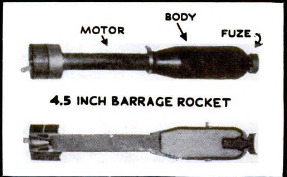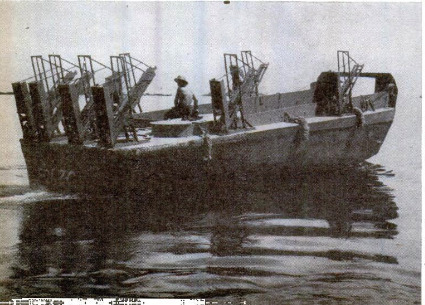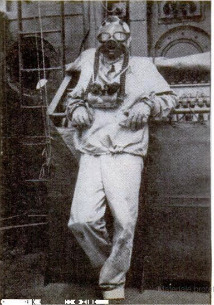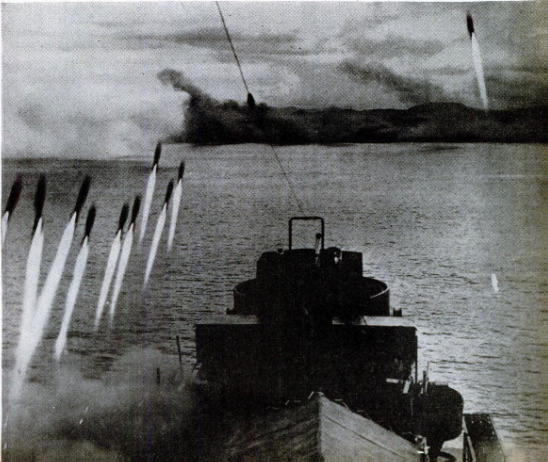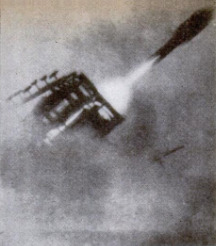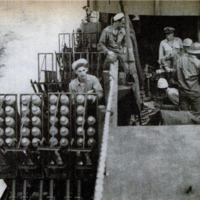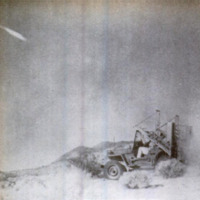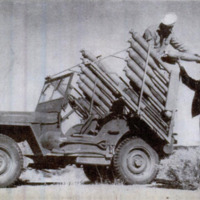-
Title (Dublin Core)
-
Zoom boats sock like battleships
-
Article Title and/or Image Caption (Dublin Core)
-
Zoom boats sock like battleships
-
extracted text (Extract Text)
-
ORANGE flames flash and smoke puffs
along the decks as American landing
craft approach hostile shores. But these jets
of fire in the dawn's dim light cheer the men
about to land, for they mark the departure
of a salvo of rockets to clear the coast of
Japs.
Each rocket whooshing forward will hit
like a 105-millimeter shell, and hundreds of
rockets now can be shot electrically from
the tilted crates along the sides of a single
landing craft. All told, the short-range
salvos from one rocket-firing craft may be
a fourth greater than the firepower of two
of our modern, New Jersey class, 45,000-ton
battleships.
Rockets are an ancient weapon; they
stopped Kublai Khan in the thirteenth cen-
tury. But they have been improved so
greatly so recently that the Navy spent
10 times as many million dollars to produce
them in 1944 as in 1943. And now, more
huge rocket factories are being built—to
supply the armed forces with more mil-
lions of dollars’ worth of rockets per month
this year than were ever made before per
year,
The beach-barrage rocket that is clearing
the way for American invaders in the
Pacific weighs a little more than 15 pounds.
Its body is 4.5 inches in diameter and is
loaded with a high explosive. On its nose
there is a tiny wheel that is whirled by the
wind when the rocket swishes into the air.
This arms the fuse, which touches off the
explosive payload in the body of the rocket
when it strikes upon the enemy’s ramparts.
Behind the explosive head of the projec-
tile is a “motor” consisting of a long, nar-
Tow tube of propellent powder and an elec-
trical wiring system. Current to start this
motor is supplied by batteries, charged by
generators fed by the ship's engines. Con-
tact between these batteries and the wiring
within the rocket is made by a little wire,
known as a pigtail, which extends from the
rocket’s tail into the launching rack.
When current flows into the wiring sys-
tem through the pigtail, the propellent pow-
der is ignited at the end near the payload.
The fire travels backwards through this
tube of powder. It burns more slowly and
steadily than ordinary gunpowder and emits
fiery gases. These escape through a nozzle
in the tail and thus drive the rocket for-
ward.
There is a loud hiss, rather than a boom,
when a rocket is fired. The tail jet is 50
hot that men take cover before launching
these rockets and wear asbestos suits when
working with them. But this bright, yellow-
ish, torchlike flame lasts only long enough
to lift the rocket well into the air. It ceases
before the projectile begins its descent to-
ward the target.
The effect on the enemy is similar to
that of heavy mortar fire. Rockets do not
have the velocity or high degree of accuracy
of artillery. But
they can be fired so that each salvo overlaps
a previous one. Targets may be determined
by using ranging rockets. And the blast
effect and fragmentation from a barrage of
bursting rockets can be employed to make
the area where men are about to land too
hot and lively for the foe to linger there.
Secondary fortifications, including mines,
wire, machine-gun nests, and shallow pill-
boxes can be virtually eliminated. Even men
protected by large, strong fortifications can
be temporarily stunned by a rocket bom-
bardment.
The 4.5-inch rocket, moreover, is only one
of several calibers now in use. The smallest
is called a SCAR, sub-caliber aircraft rock-
et, and is only 2.5 inches in diameter. The
largest is five inches in diameter. Recent
developments, however, have made it possi-
ble to produce bigger rockets, aim them
more certainly, and use them at longer
ranges. For example, it has been suggested
that an automatic computing device similar
to the electronic bombsights now in use
might enable a fighter-plane pilot to launch
rockets at a target with greater accuracy.
Since there is no recoil, the apparatus
from which rockets are launched can be
lighter and much simpler than a gun. The
US. Navy put rocket launchers on its
LCS (8), landing craft, support (small),
while the British were putting them on their
LCT (R), landing craft, tank (rocket).
Some of the latter craft were turned over to
this country more than a year ago. After
careful tests, Navy authorities ordered more
of them converted to American designs and
specifications with the utmost speed. Until
recently, these vessels were definitely hush-
hush.
Meanwhile, rockets were used with sensa-
tional success on the Navy's LCI (G),
landing craft, infantry (gunboat), in the
Pacific. A single LCI skipper estimated that
his craft fired 1,000 rockets into the beaches
of Guam.
‘Washington authorities report that the
Japs have made comparatively little use
of rockets. But American officers have
found that invasion casualties can be re-
duced by using more rockets.
The Army is directing the production of
propellent powder, and the Navy is in
charge of assembling, loading, and testing
rockets. Homec-front workers are being
asked to turn them out faster, in greater
quantities, to save American lives.—VOLTA
TORREY.
-
Language (Dublin Core)
-
eng
-
Date Issued (Dublin Core)
-
1945-03
-
pages (Bibliographic Ontology)
-
82-84,232
-
Rights (Dublin Core)
-
Public domain
-
Archived by (Dublin Core)
-
Sami Akbiyik
-
Marco Bortolami (editor)
 Popular Science Monthly, v. 146. n. 3. 1945
Popular Science Monthly, v. 146. n. 3. 1945

